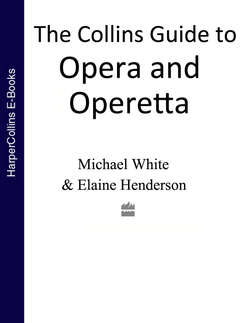Читать книгу The Collins Guide To Opera And Operetta - Michael White - Страница 42
ОглавлениеGloriana
FORM: Opera in three acts; in English
COMPOSER: Benjamin Britten (1913–76)
LIBRETTO: William Plomer; after Lytton Strachey’s biography
FIRST PERFORMANCE: London, 8 June 1953
Principal Characters
Elizabeth I Soprano
Earl of Essex Tenor
Frances, Countess of Essex Mezzo-soprano
Lady Penelope Rich, Essex’s sister Soprano
Lord Mountjoy Baritone
Sir Walter Raleigh, captain of the guard Bass
Sir Robert Cecil, secretary of the council Baritone
Synopsis of the Plot
Setting: London and Norwich; the later years of Elizabeth’s reign
ACT I The queen is at a tournament when Essex, hot-blooded and ambitious, provokes a quarrel with Mountjoy, the tournament victor, whom he sees as a rival for the queen’s favour. Elizabeth is displeased at this and urges them to become reconciled. Later, Robert Cecil cautions the queen about showing too much affection for Essex, who is trying to persuade Elizabeth to let him go to Ireland to repress the Tyrone rebellion.
ACT II Elizabeth is making a state visit to Norwich, attended by Essex, who seems impatient of the ceremonials. He is still anxious to set off for Ireland and complains to his wife, Frances, of the queen’s unwillingness to let him go. Frances urges caution, but Essex is confident that he has Elizabeth’s affection and that his power and influence will increase accordingly. Once more in London, Essex instructs his wife to attend a ball in her most extravagant dress, even though Frances knows that this will antagonise the queen. Elizabeth orders some energetic dancing, after which the ladies retire to change their linen. When Frances returns she is in a much more subdued outfit, complaining that her dress has been stolen. And when Elizabeth next appears it is clear who stole it – but the dress is much too small for her and she looks grotesque. Essex’s anger mounts higher and higher at this insult, but the queen mollifies him by finally agreeing that he can go to Ireland as the Lord Deputy.
ACT III Essex has failed to quell the Irish rebellion and is trying to put the blame on his enemies at court. Cecil tells the queen that Essex is stirring up revolt in England and, reluctantly, she orders that he be kept under guard. The evidence against Essex begins to accumulate and the councillors, led by Cecil, try to persuade the queen to sign his death warrant. Frances comes to appeal for his life and elicits a sympathetic response from the queen, but when her companion, Lady Rich, arrogantly tells Elizabeth that she should pardon Essex because she needs him, Elizabeth promptly calls for the death warrant and signs it.
Music and Background
A ceremonial piece, written for the coronation of Queen Elizabeth II, Gloriana proceeds in a sequence of tableaux with much spectacle – in sound as well as vision – and cleverly contemporised allusions to the music of the Tudor court. But the writing balances these grand public statements against intimate scenes in which Elizabeth gives voice to her private feelings with touching poignancy. Everything hangs on the central role which is accordingly long, taxing and in every sense a tour de force.
Highlights
The Earl of Essex’s hauntingly beautiful second lute song, ‘Happy were he’ in Act I; the sequence of ceremonial dances and choral numbers that comprise the masque in Act II; the courtly dances of the Act II Ball Scene; the queen’s final monologue as a dream-sequence of episodes from her life and reign pass before her.
Did You Know?
Gloriana drew muted applause at its premiere, partly because the glittering audience of diplomats, royalty and other coronation guests didn’t know what to make of it but largely because they were wearing full court dress, including white gloves.
Recommended Recording
Josephine Barstow, Philip Langridge, Della Jones, Welsh National Opera/Charles Mackerras. Decca 440213-2. The only full recording, produced in 1993, with a superb roster of latterday British voices that features in Barstow the finest modern exponent of the central role.
